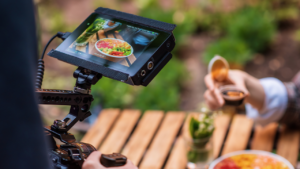


Food photography is an art form that allows you to capture and showcase your culinary creations in all their mouthwatering glory. Whether you are a professional food photographer or simply want to up your Instagram game, these tips will help you take captivating photos that truly do justice to the deliciousness of your dishes.
When it comes to food photography, lighting plays a vital role in determining the overall quality of your images. Natural light is often the best choice, as it provides a soft and even illumination that enhances the colors and textures of your food. Choose a spot near a window or set up your shooting area outdoors. Avoid harsh artificial lighting that can cast unflattering shadows or distort the colors of your dishes.
Make the most of the “golden hour” – the hour after sunrise or the hour before sunset – when the natural light is warm and soft. This gentle, diffused light can create a magical ambiance and add a touch of enchantment to your food photography. Experiment with different angles and positions to capture the play of light and create stunning compositions.
If you find yourself shooting in harsh sunlight, use a diffuser to soften and scatter the light. A simple white sheet or a purpose-made diffuser can help create an even glow, preventing harsh shadows and reducing unwanted reflections. This technique will add a professional touch to your photos, making your culinary creations look even more inviting.
Capturing the essence of a beautifully plated dish requires careful consideration of composition. The arrangement of your food, props, and background all work together to create a visually appealing image that tells a story.
Using the rule of thirds is an effective composition technique that creates balance and visual interest. Imagine your photo divided into a grid with nine equal parts, and place key elements of your composition along these lines or at their intersections. By doing so, you can draw the viewer’s attention to the most important parts of your dish and create a harmonious composition.
Experiment with different props and backgrounds to highlight the unique characteristics of your culinary creations. Choose plates, utensils, and fabrics that complement and enhance the colors and textures of your dish. Consider the overall mood you want to convey and select props accordingly. Additionally, using different backgrounds such as rustic wood, clean marble, or textured fabrics can add depth and interest to your photos.
Just as you carefully season and garnish your dishes to enhance their flavors, styling plays a crucial role in food photography. Pay attention to the small details that can make your culinary creations look even more enticing on camera.
Sprinkle your dish with fresh herbs, drizzle sauces, or strategically place a dollop of cream to add visual interest and showcase the flavors. These finishing touches can make all the difference and create a sensory experience even through a photograph.
Photography is a visual medium, so highlighting the textures of your food is crucial in capturing its mouthwatering essence. Whether it’s the crispy edges of your roasted vegetables or the velvety smoothness of your chocolate mousse, find angles and lighting that showcase the details and invoke a desire to take a bite.
After capturing your culinary creations, a final touch of post-processing can elevate your food photos to an even higher level of visual appeal. Editing should be subtle and enhance the original essence of your dishes without altering them beyond recognition.
Make sure the colors in your photo accurately represent the actual colors of your food. Adjust the white balance to ensure that whites appear white and other colors are true to life. Additionally, fine-tune the exposure to bring out the details and create a well-balanced image.
A gentle touch of sharpening can enhance the details and textures in your food photos. Be careful not to overdo it, as it can create an artificial and unappealing look. Additionally, consider adjusting the saturation and vibrance to make the colors pop without losing their natural beauty.
By following these food photography tips, you can capture the true essence and beauty of your culinary creations. Remember, practice makes perfect, so experiment, have fun, and let your creativity shine through your lens. Get ready to tantalize taste buds and inspire others with your stunning food photography skills!
100% Original product, do not sale them as we are licensed.
Your payments are secure with our private security network.